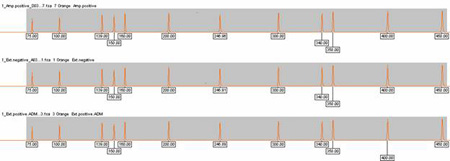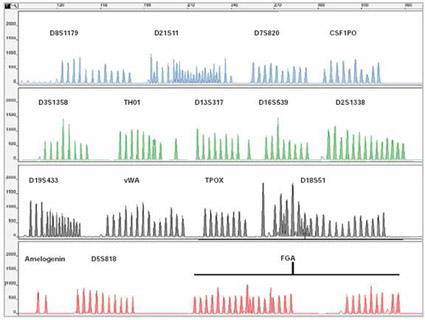Archival Notice
This is an archive page that is no longer being updated. It may contain outdated information and links may no longer function as originally intended.
Home | Glossary | Resources | Help | Contact Us | Course Map
The steps for assigning an allele call to each peak are:
- Data collection
- Peak recognition
- Color separation
- Peak sizing
- Allelic ladder comparison
- Allele assignment (i.e., genotype)
DNA fragments, represented as peaks on an electropherogram, can be sized relative to the internal size standard (ISS), which is mixed in with the amplified product.
For forensic short tandem repeat (STR) testing, allele sizes must have a sizing precision of a single base. Variables such as temperature, sample and buffer ionic strengths, osmotic flow, and electric field can all influence DNA mobility. The DNA fragments are sized by comparing their migration time with that of flanking internal standard peaks. The size is then calculated by interpolation, assuming a linear relationship between peaks.
Sequence variation and attachment of dyes affect the size of the fragments. The size of an individual fragment is determined by comparison with the internal size standard. The allelic designation is determined by comparing its assigned size with the allelic ladder. This ISS is labeled with a different colored dye so that it can be distinguished from the DNA fragments in the sample. The ISS generally contains DNA fragments spanning the size range.
ABI uses three software programs for the genotyping process:
- GeneScan®
- Genotyper®
- GeneMapper® ID
GeneScan® software spectrally resolves the dye colors for each peak and is used to size the DNA fragments in each sample. These data are then imported in the Genotyper® program, which compares the sizes of alleles in the allelic ladder to those obtained for each sample. GeneMapper® ID is a program that was released by Applied Biosystems (AB) in 2003, which combines the functions of GeneScan® and Genotyper®.
Additional Online Courses
- What Every First Responding Officer Should Know About DNA Evidence
- Collecting DNA Evidence at Property Crime Scenes
- DNA – A Prosecutor’s Practice Notebook
- Crime Scene and DNA Basics
- Laboratory Safety Programs
- DNA Amplification
- Population Genetics and Statistics
- Non-STR DNA Markers: SNPs, Y-STRs, LCN and mtDNA
- Firearms Examiner Training
- Forensic DNA Education for Law Enforcement Decisionmakers
- What Every Investigator and Evidence Technician Should Know About DNA Evidence
- Principles of Forensic DNA for Officers of the Court
- Law 101: Legal Guide for the Forensic Expert
- Laboratory Orientation and Testing of Body Fluids and Tissues
- DNA Extraction and Quantitation
- STR Data Analysis and Interpretation
- Communication Skills, Report Writing, and Courtroom Testimony
- Español for Law Enforcement
- Amplified DNA Product Separation for Forensic Analysts



